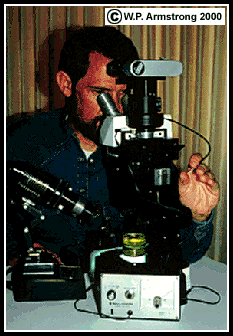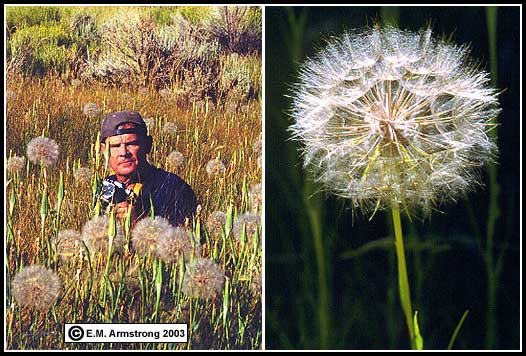
|

Mr. Wolffia, the editor of WAYNE'S WORD, photographing living specimens of two minute aquatic plant species, the Asian Wolffia globosa and the Australian Wolffia angusta, through a Bausch & Lomb dissecting microscope. These are the undisputed world's smallest flowering plants. Individual plants are less than one millimeter in length and have seldom been seen by mortal humans.

|
Wayne P. Armstrong (alias Mr. Wolffia), a native Californian, grew up in the Arcadia-Pasadena area of Los Angeles County. He graduated from
California State University at Los Angeles with a Bachelor's
Degree in Botany and a Master's Degree in Biology. He has taken
numerous graduate courses in biology and botany at the University of
California at San Diego, San Diego State University and San Jose
State University, including courses in ethnobotany, cellular
biology, ecology and field seminars in alpine and subalpine
botany. He also received National Science Foundation Grants in
biological oceanography, ecology and tropical botany at Oregon
State University, Colorado State University and the University of
Miami.
Professor Armstrong joined the Life Sciences Department of
Palomar College in 1966 as an associate professor of biology and
botany. In addition to General Biology (Biology 100) and General
Botany (Botany 100), he also teaches courses in Botany of Spring Wildflowers (Botany 110) and a popular economic botany
course called Plants and People (Botany 115). With the rapid popularity of the Internet, Professor Armstrong has also developed on-line versions of his lecture courses: Plants and People (Botany 115) and General Biology (Biology 101). The courses are completely on-line, with no meetings on campus. Both courses are based on the thousands of pages of lecture notes that were laboriously placed on blackboards and whiteboards for more than thirty years. Now all of this material plus more than 2,300 photo images and illustrations are available on-line in Professor Armstrong's massive website called Wayne's Word: An On-Line Textbook of Natural History. Details of the on-line courses can be found on the Wayne's Word website. Wayne's Word can be accessed through Palomar College at the following two URLs:
During his career at Palomar College, Professor Armstrong has been instrumental in establishing the Palomar College Arboretum, the Coastal Sage Scrub Preserve northeast of the campus, and the Palomar College Herbarium. The latter collection received international herbarium status with
the acronym PASM, and is listed in Index Herbariorum (Herbaria of
the World) at the
Missouri Botanical Garden WWW site. He has also served as
co-instructor on numerous national and international Palomar
College Field Expeditions to the U.S. Virgin Islands, Yucatan,
French Polynesia, Ecuador (The Galapagos Islands and Napo
River--a tributary of the Amazon), Grand Cayman, Belize,
Guatemala, Honduras, Costa Rica and Dominica.
In addition to teaching biology and botany courses at Palomar
College, Wayne served as a contributing editor for Herbalgram, the
journal of the American Botanical Council and Herb Research
Foundation. He has been a contributor/consultant for numerous
environmental and floristic studies, including the Oregon Flora
Project (Oregon State University) and the Flora of North America
Project (Missouri Botanical Garden), and has verified the
identification of Lemnaceae species for research botanists from
throughout the United States and other countries. His research interests include the
taxonomy of the duckweed family (Lemnaceae), California
floristics, post-burn plant succession, lichen symbiosis, fig
pollination, tropical drift seeds, natural seed jewelry, and
botanical natural history. As stated above, he is also the author and editor of
an award-winning web site called
Wayne's Word: An On-Line Textbook of Natural History
(published on-line through Palomar College) and
Lemnaceae On-Line: A Pictorial and Descriptive Taxonomic Key
to The Duckweeds of North America (also published on-line through
Palomar College).
His 200 botanical articles and photographs have
appeared in numerous natural history publications including:
Pacific Discovery (California Academy of Sciences), Terra (Los
Angeles County Museum of Natural History), Environment Southwest
(San Diego Society of Natural History), Pacific Horticulture
(California Horticultural Society), World Magazine (National
Geographic Society), Madrono (California Botanical Society),
Zoonooz (San Diego Zoological Society), California Garden (San Diego Floral Association), Fremontia (California Native Plant
Society), Ornament (International Bead Journal), Ocean Realm
(Friends of the Sea), Herbalgram (American Botanical Council) and
Sea Frontiers (International Oceanographic Foundation).
In addition to full length published articles, many of his
photos, descriptions and articles have appeared in other
publications, including the following books: Chapter 9: "The
Closed-Cone Pine and Cypresses" in Terrestrial Vegetation of California (John Wiley & Sons); "Duckweed Photos and
Descriptions" in A Monograph of the Lemnaceae by E. Landolt
(Swiss Geobotanical Institute, Zurich); "Smallest Flowering Plant
and Smallest Fruit" in Guinness Book of World Records; "Duckweed
Photos and Descriptions" in Biology of Plants by Peter Raven
(Worth Publishers); "Ocean Drift Seeds" in The New Book of Knowledge And Popular Science Annual 1992, 1999, and 2000 (Grolier Publishing
Company); "Section on Lemnaceae" in the Flora of San Diego County
by R.M. Beauchamp; "Section on Lemnaceae" in Jepson's Flora of California (University of California Press); and "Section on
Lemnaceae" in the forthcoming Neotropical Plant Families (New
York Botanical Garden).
Wayne says, "writing allows me to vent my enthusiasm and
creativity beyond the classroom and contribute to my field."

|
Collecting Lemna obscura on the island of Kauai.
|
|
Research in the herbarium of Rancho Santa Ana Botanic Garden in Claremont, California.
|
|
Studying floral variation in coral tree (Erythrina) flowers. Some of these flowers are typically pollinated by hummingbirds, while others are pollinated by perching birds (passerines).
|
|
Left: Tuolumne Meadows, Yosemite National Park with the legendary naturalist Dr. Carl Sharsmith, authority on the flora and fauna of the Sierra Nevada. Right: Photographing the silver sword on Haleakala Crater on the island of Maui.
|

|
Left: Botany 110 field trip to Anza-Borrego Desert. Right: Discovering the unusual parasitic broomrape Orobanche corymbosa attached to the roots of sagebrush (Artemisia tridentata) in the subalpine Sierra Nevada.
|

|
Mr. Wolffia photographing western salsify Tragopogon dubius in the sagebrush scrub (Artemisia tridentata) of the eastern Sierra Nevada.
|
|
Mr. Wolffia photographing the remarkable "monkey puzzle" tree (Araucaria araucana), a tree that is difficult (and painful) to climb for monkeys and people.
|
|
Mr, Wolffia (foreground) and geologist Henry Ivey collected brine in Searles Lake. Mineral-rich brine is pumped to the large Kerr-McGee Chemical Plant in Trona, California where valuable minerals are recovered. The brine samples contained a homogeneous population of the green alga Dunaliella salina.
|
|